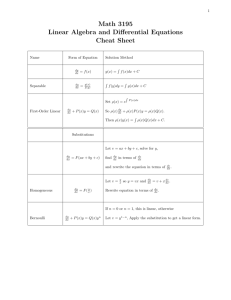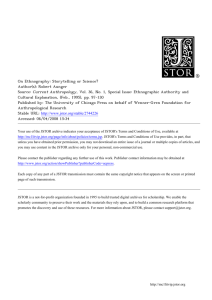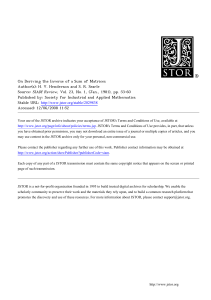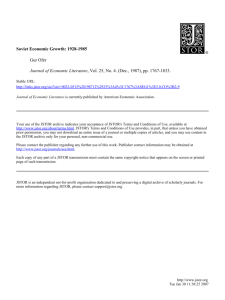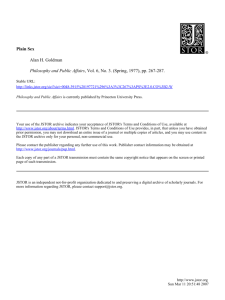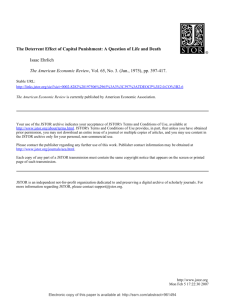paper by Cayley - University of South Alabama
advertisement
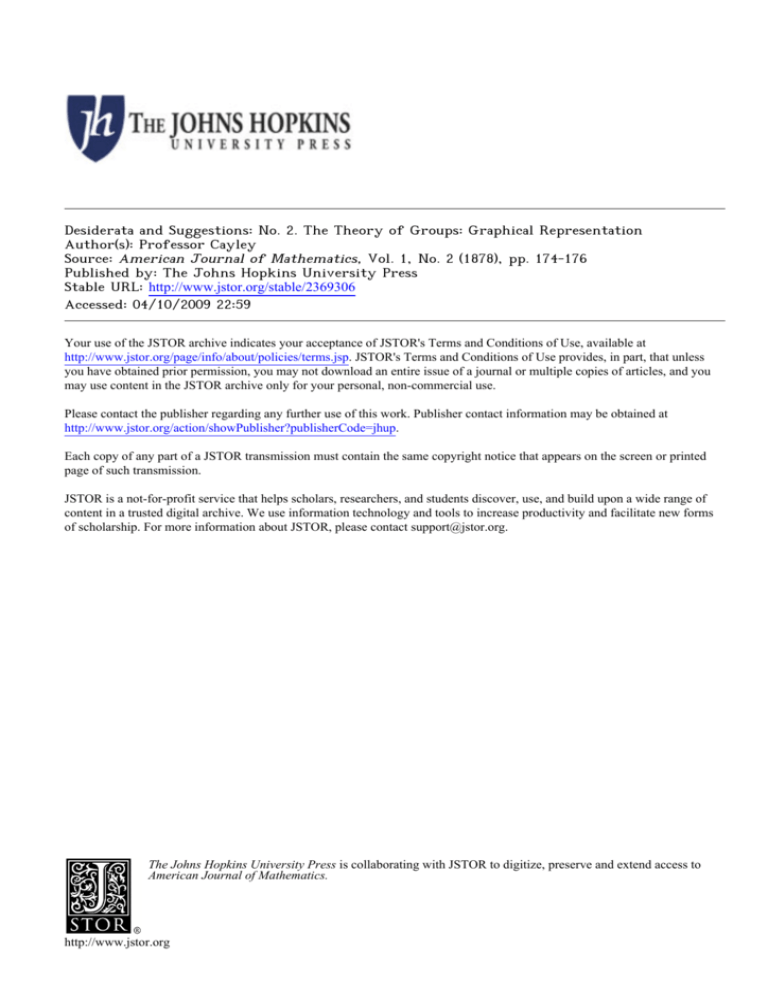
Desiderata and Suggestions: No. 2. The Theory of Groups: Graphical Representation Author(s): Professor Cayley Source: American Journal of Mathematics, Vol. 1, No. 2 (1878), pp. 174-176 Published by: The Johns Hopkins University Press Stable URL: http://www.jstor.org/stable/2369306 Accessed: 04/10/2009 22:59 Your use of the JSTOR archive indicates your acceptance of JSTOR's Terms and Conditions of Use, available at http://www.jstor.org/page/info/about/policies/terms.jsp. JSTOR's Terms and Conditions of Use provides, in part, that unless you have obtained prior permission, you may not download an entire issue of a journal or multiple copies of articles, and you may use content in the JSTOR archive only for your personal, non-commercial use. Please contact the publisher regarding any further use of this work. Publisher contact information may be obtained at http://www.jstor.org/action/showPublisher?publisherCode=jhup. Each copy of any part of a JSTOR transmission must contain the same copyright notice that appears on the screen or printed page of such transmission. JSTOR is a not-for-profit service that helps scholars, researchers, and students discover, use, and build upon a wide range of content in a trusted digital archive. We use information technology and tools to increase productivity and facilitate new forms of scholarship. For more information about JSTOR, please contact support@jstor.org. The Johns Hopkins University Press is collaborating with JSTOR to digitize, preserve and extend access to American Journal of Mathematics. http://www.jstor.org DESIDERATA AND SUGGESTIONS. BY PROFESSOR CAYLEY, Cambridqe,Enqland. No. 2.-THE THEORY OF GROUPS: GRAPHICAL REPRESENTATION. IN regard to a substitution-group of the order n upon the same nunmber of letters, I omitted to mention the important theorem that every substitution is regular (that is, either cyclical or composed of a number of cycles each of them of the same order). Thus 'in the group of 6 given in No. 1, writing a, b, c, d, e, f in place of 1, a, 3 y, S , the substitutions of the group are 1, ace.bfd, aec.bdf, ab.cd.ef, ad.be.cf, af.bc.de. Let the letters be represented by points; a change a into b will be represented by a directed line (line with an arrow) joining the two points; and therefore a cycle abc, that is, a into b, b into c, c into a, by the three sides of the trilateral abc, with the three arrows pointing accordingly, and similarly for the cycles abed, &c.: the cycle ab means a into b, b into a, and we have here the line ab with a two headed arrow pointing both ways; such a line may be regarded as a bilateral. A substitution is thus represented by a multilateral or system of multilaterals, each side with its arrow; and in the case of a regular substitution the multilaterals (if more than one) have each of them the same number of sides. To represent two or more substitutions we require different colours, the mnultilateralsbelonlging to any one substitution being of the same colour. In order to represent a group we need to represent only independent substitutions thereof; that is, substitutions such that no one of them can be obtained from the others by comnpoundingthem together in any manner. I take as aniexample a group of the order 12 upon 12 letters, where the number of independent substitutions is = 2. See the diagram, wherein the continuous lines represent black lines, and the broken lines, redclines. a X 17-L ,/< "fi g i b t , E~/ E './ -- 4, ? a CAYLEY, -Desiderataand Suqgestions. 175 The diagram is drawn, in the first instance, with the arrows but without the letters, which are then affixed at pleasure; iz: the form of groupis quite indepencdent of the way in which this is done, though the group itself is of course dependent upon it. The diagram shows two substitutions, each of them of the third order, one represented by the black triangles, and the other by the red triangles. It will be observed that there is from each point of the diagramn(that is, in the direction of the arrow) one and onily one black line, and one and only one red line; hence, a symbol, B, "move along a black line," B2, move successively along two black lines," BR (read always from right to left), " move first along a red line and then alolng a black line," has in every case a perfectly definite meaning and determines the path when the initial point is given; any such symbol may be spoken of as a " route." The diagram has a remarkable property, in virtue whkereofit ini act represents a group; It nmaybe seen that any route leading fromnsome one point a to itself, leads also from every other point to itself, or say from b to b, from c to c, . . . . and from 1to 1. We hence see that a route applied in succession to the whole series of initial points or letters abcdefghijkl,gives a new arrangenmentof these letters, wherein no one of them occuipies its original place; a route is thus, in effect, a substitution. Moreover, we mnayregard as distinct routes, those which lead from a to a, to b, to c, . . . to 1, respectively. We have thus 12 substitutions (the first of them, which leaves the arrangement unaltered, being the substitution unity), and these 12 substitutions formna group. I omit the details of the proof; it will be suLfficientto give the square obtainied by means of the several routes, or substitutions, performnedupon the primitive arrangement abcdefghijkl, and the cyclical expressions of the a b c d e f b c a 1 j k k I gf h i j k I c d a e b f h a i b gc d e i g h I j e f d j k h i g f g h d h i e i g j e c k fa I d b c i j d k e ag b h 1 f k b a I 1 c b j j a c k e f d g h i i g h k j k 1 ,f d j e b a c a f d e b c g h i k I I j j k i b gc h a e h f i d g c d a e b f 1 abc . def . ghi. jcl( jlk acb . dfe . gih. bl . ch . egj . ik ad. aeh . bjd . cil. fg eij fl . bkh . cgd. agj . fi .cke .dlh ahe . bdj .cli. fgk . dk .fh.gl ai .be.cj . dhl( ajg . bif .cek di.el.hj akl.bg.qf. cdg. eji alf .bh B) R). 176 CAYLEY, IDesiderataand Suggestions. substitutions theinselves: it will be observed that the substitutions are unity, 3 substitutions of the order (or index) 2, and 8 substitutions of the order (or index) 3. It may be remarked that the group of 12 is really the group of the 12 positive substitutions uporn4 letters abed, viz., these are 1, abG, aeb, abd, adb, aed, ade, bed, bdc, ab.cd, ac.bd, ad.bc. CAMBRIDGE, 16GhMay, 1878.

